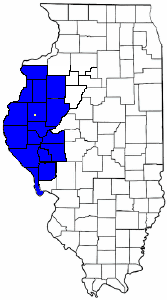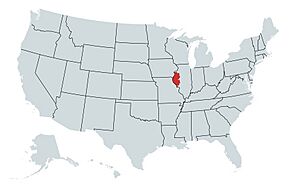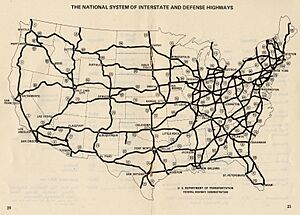Forgottonia facts for kids
Forgottonia (pronounced "for-got-TOH-nee-uh") is a special name given to a part of Western Illinois in the late 1960s and early 1970s. It includes 16 counties that form a unique bulge on the western side of Illinois, right between the Illinois and Mississippi rivers. Because of its location, this area has historically felt a bit cut off from the rest of Central Illinois.
The name Forgottonia was thought up by Jack Horn, John Armstrong, and Neil Gamm. They were frustrated because their part of Illinois wasn't getting enough help from the state and federal governments for important projects like roads and transportation. For example, plans for a major highway from Chicago to Kansas City that would go through Western Illinois were turned down many times. Also, train service from Quincy and Macomb to Chicago was stopped for a while. Even a college, Carthage College, moved away to Wisconsin!
Later, in the 1980s, Congressman Dick Durbin used the name "Forgottonia" to talk about the region's problems, including issues with communication services like educational TV and internet. Even today, the area still faces challenges, with some counties experiencing poverty.
Back in the 1970s, there were only a few bridges over the Illinois River south of Peoria, and some free ferries. The big Valley City Eagle bridge for Interstate 72 wasn't finished until the late 1980s. Many of the Mississippi River bridges were toll bridges, meaning you had to pay to cross them.

Why the Name "Forgottonia"?
The name Forgottonia was a way for people to protest. They felt that their region was being "forgotten" when it came to money for roads, communication, and jobs after World War II.
The Highway That Wasn't Built
In 1955, when the big Federal Aid Highway Act of 1956 was being planned, a major interstate highway from Chicago to Kansas City was supposed to go through the heart of this region. But other states and railroad companies objected, and the route was removed. This meant Western Illinois missed out on a key transportation link.
Later, in the 1960s and 1970s, plans for this Chicago-Kansas City highway were brought up again but were always defeated in the U.S. Congress. These decisions led to businesses and people leaving the area. This made the residents even more determined to speak up.
A Fictional State
In the early 1970s, people in McDonough County came up with the idea of Forgottonia as a fictional new state or even an independent country. Western Illinois University student Neil Gamm was jokingly named "governor," and the small town of Fandon was chosen as the "capital." The name stuck because it truly felt like the region was "forgotten" by politicians and business leaders.
Bringing Back Train Service
When train service was cut in 1971, the State of Illinois stepped in to help. They created the "Illinois Service" initiative, which helped bring back Amtrak train service. This service is still partly funded by the Illinois Department of Transportation today.
Counties of Forgottonia
Here are the 16 counties that were part of the original Forgottonia movement:
The small village of Bernadotte in Fulton County was once almost chosen as the capital of Illinois, but it lost by just one vote! In 2010, about 354,709 people lived in these 16 Forgottonia counties.
Transportation Projects Since 1972
Even after the Forgottonia movement, efforts continued to improve transportation in the region.
Avenue of the Saints Highway
A major highway called the "Avenue of the Saints" (connecting St. Paul, Minnesota to St. Louis, Missouri) was first suggested in 1955. One idea was for it to go through Western Illinois. However, this route was not chosen.
In the 1980s, the idea was brought back. Many people supported it, including future Iowa governor Tom Vilsack. This time, the highway was planned to mostly go through Iowa and Missouri, not Western Illinois. This means cities like Quincy, IL still need to use other roads to reach it.
Amtrak Train Service
Since the region didn't get a major interstate highway, the "Illinois Service" for Amtrak trains was approved in 1971. The Illinois Zephyr train started running daily from Chicago to Quincy, right through the heart of Forgottonia. This train has become one of Amtrak's most successful routes!
In 2006, another daily train, the Carl Sandburg, was added to this route. This means there are now morning and evening trains in both directions, helping more people travel to and from the region.
Interstate 72 (Central Illinois Expressway)
Construction on the Central Illinois Expressway, now known as Interstate 72 (I-72), began in the late 1970s and was finished in 1991. This highway helped the southern counties of Forgottonia, giving cities like Quincy and Pittsfield easier access to Springfield and other parts of Illinois.
Later, Missouri also completed its part of Interstate 72, connecting Hannibal, Missouri, to St. Joseph, Missouri. This route is also known as Chicago-Kansas City - Missouri Route 110.
Illinois Route 336
In 2009, construction on Illinois Route 336 was extended from Quincy to Macomb. This new road helps communities like Quincy, Carthage, and Macomb connect better to Interstate 72 and other routes towards Kansas City. A bypass around Macomb was completed in 2018.
Illinois Route 110 (Chicago-Kansas City)
The idea of a Chicago-to-Kansas City expressway was looked at again in 1989. While it would have been very expensive, it showed how much people wanted this connection.
In 2010, Illinois lawmakers decided to name an expressway project connecting Chicago to Kansas City as Illinois Route 110. This route uses parts of many existing highways, including Illinois Route 336, Interstate 72, and U.S. Route 67. It connects cities like Quincy, Macomb, and Galesburg to Chicago.
River Bridges
Since the 1970s, several new bridges have been built over the Mississippi River, making it easier to travel west from Forgottonia into Missouri and Iowa. These include the Mark Twain Memorial Bridge at Hannibal and the Bayview Bridge at Quincy.
However, many of the Illinois River highway bridges that connect Forgottonia to Central Illinois are over 50 years old. While they are maintained, they are not yet funded for full replacement. A new bridge at Meredosia was finished in 2018, and a replacement for the US 67 bridge at Beardstown is planned.
U.S. Route 67 in Illinois
While U.S. Route 67 in Missouri is a high-priority trade route, the section of U.S. Route 67 in Illinois that goes through Forgottonia does not have the same priority. Parts of it north of Macomb have been upgraded to four lanes, but many sections further south still need improvements.
Culture in Forgottonia
Colleges and Universities
Forgottonia is home to several colleges and universities:
- Western Illinois University (WIU) in Macomb
- Knox College in Galesburg
- Carl Sandburg College in Galesburg, with campuses in Carthage and Bushnell
- Quincy University in Quincy
- John Wood Community College in Quincy, with centers in Pittsfield, Perry, and Mt. Sterling
- Spoon River College near Canton, with a campus in Macomb
- Illinois College in Jacksonville
- Monmouth College in Monmouth
- Lincoln Land Community College has branches in Jacksonville and Beardstown
Public Television
In 1970, Western Illinois was one of the few areas in the U.S. without its own PBS television station. People had to watch stations from other cities or states.
How the States Got Their Shapes
In 2011, The History Channel show How the States Got Their Shapes featured Forgottonia. It talked about how the region was treated unfairly when the national highway system was built. Neil Gamm, the "governor" of Forgottonia, was even interviewed for the show!
Local Businesses and News
- Forgottonia Brewing, a brewery that opened in Macomb, Illinois in 2019, is named after the social movement.
- The Forgottonia Times is a monthly newspaper that started in July 2024. It aims to provide local news to the counties of Knox, Warren, Fulton, and McDonough, feeling that larger newspapers don't connect enough with the area. It's mailed free to 60,000 homes in the region.




